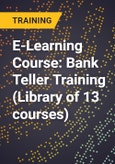This library deals with the day to day functions in a bank carried out by the tellers. It explains the basic role of a teller and tells about checks and check handling. Further it details about various transaction processing in a bank and handling of cash by the tellers in the bank during a day. The library also covers cash balancing process by the banks and provides an overview of various bank services. How banks keep security and how do they do customer service is also discussed in the library. This library also deals with the marketing that the bank adopts for its services. Lastly, the library deals with the current form of banking, i.e., electronic banking and provides guidelines for ‘know your customers’ to the banks.
Learning Objective:
Role of the Teller
Checks and Check Handling- Part 1
Checks and Check Handling- Part 2
Processing Transactions - Part 1
Processing Transactions - Part 2
Handling Cash
Cash Balancing
Overview of Bank Services
Bank Security
Customer Service
Marketing of Bank Services
Electronic Banking
Know Your Customer Guidelines
Target Audience
Those who are interested in the day to day operation of the bank.
Learning Objective:
Role of the Teller
Checks and Check Handling- Part 1
Checks and Check Handling- Part 2
Processing Transactions - Part 1
Processing Transactions - Part 2
Handling Cash
Cash Balancing
Overview of Bank Services
Bank Security
Customer Service
Marketing of Bank Services
Electronic Banking
Know Your Customer Guidelines
Target Audience
Those who are interested in the day to day operation of the bank.
Course Content
1. Role of the TellerOn completion of this course, you will be able to:
Define the term 'Bank' and explain the functions of a bank
Explain how banks make money
List the teller's main areas of responsibility
Identify the knowledge and skills required for tellers
Explain the basic teller principles
2. Checks and Check Handling- Part 1
On completion of this course, you will be able to:
Define check
Identify the different components of a check
Determine if a check is negotiable and acceptable
List the types of checks
3. Checks and Check Handling- Part 2
After the successful completion of this course, you will be able to:
Recognize warning signs that may indicate forged or altered checks
Describe endorsements
List the types of endorsements
Identify forged endorsements
Recognize acceptable forms of identification of customers and their signatures
Explain check cashing and list teller guidelines for check cashing
4. Processing Transactions - Part 1
After the successful completion of this course, you will be able to:
List the types of bank accounts
Process the basic checking account transactions
Explain the regulation that governs the checking account transactions
Process deposits to the savings account
Process withdrawal forms for the savings account
Explain how teller's work affects other areas of the bank
Explain 'Check 21'
5. Processing Transactions - Part 2
After successful completion of this course, you will be able to:
Understand the basic ideas and methodology for documenting currency transaction report (CTR) and suspicious activity report (SAR)
Understand the security aspects to be considered while opening a new account, handling split deposits,and check kiting
Know the regulations that affect transaction processing
6. Handling Cash
After the successful completion of this course, you will be able to:
Explain different cash compartments and their uses
Know the importance of cash counting and how to count cash efficiently
Recognize unfit, altered, mutilated, and counterfeit currency
7. Cash Balancing
After the successful completion of this course, you will be able to:
Calculate basic cash balancing figures
Identify credits and debits
Explain the opening and closing procedure in a bank
8. Overview of Bank Services
After the successful completion of this course, you will be able to:
Spot various types of negotiable instruments
Describe the issuance of U.S. savings bonds
Recognize the procedures of loan payment and bankcard transaction processing
Know the person responsible for foreign currency and drafts in your bank
9. Bank Security
After the successful completion of this course, you will be able to:
Demonstrate appropriate behavior before, during, and after a robbery
Respond to bomb and kidnapping threats safely
Recognize potential con artist behavior
Demonstrate safe daily routines
Practice ethical behavior as a teller
10. Customer Service
After the successful completion of this course, you will be able to
Know and respond to the various expectations that the customers bring to the bank
Exhibit effective communication skills
Handle difficult customers professionally
Utilize the information about your bank's specific products and services to help the customers
11. Marketing of Bank Services
On completion of this course, you will be able to:
Explain the meaning of services
List the differences between products and services
List the characteristics of services
Explain bank marketing
Apply the marketing principles to banks
12. Electronic Banking
After the successful completion of this course, you will be able to:
Understand the importance and different aspects of electronic banking
Explain the use of automated teller machines (ATMs) in accomplishing the banking needs of the customers
Understand the importance of telephone banking as a part of e-banking
Explain how internet banking and mobile banking will be useful to the customers for banking needs
Understand the use of electronic fund transfer (EFT)
13. Know Your Customer Guidelines
After the successful completion of this course, you will be able to:
Understand what is KYC
Understand the goals and importance of KYC procedures or guidelines for banks and financial institutions
Know the important features of KYC
Know the process of customer identification,verification,and reviews with regard to KYC








